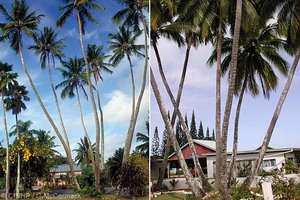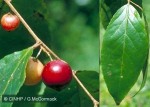Cook Islands Natural Heritage Articles
Seven Palms from One Coconut?
 On Rarotonga it is sometimes claimed that the seven palms east of the Avarua roundabout grew from one seednut. On Aitutaki it is claimed that the six palms at the Visitor Centre grew from one seednut. Are these claims fact or fiction?
On Rarotonga it is sometimes claimed that the seven palms east of the Avarua roundabout grew from one seednut. On Aitutaki it is claimed that the six palms at the Visitor Centre grew from one seednut. Are these claims fact or fiction?
A coconut has three pores at the base and, typically, a lone sprout emerges from the single soft pore. Sometimes the embryo forms a twin and two sprouts emerge through the soft pore. On very rare occasions, as once on a Lever Brothers plantation in the Solomons, an embryo developed under each of the three pores and each embryo twinned to give rise to six shoots - although only four survived.
Rarotonga's seven palms
On Rarotonga there are seven Coconut Palms in a cluster, one surrounded by six others, about 50metres east of the roundabout in Avarua. It is sometimes claimed that these palms developed from a single seednut brought from an outer island in the early 1900s, and planted in the grounds of the Administration Building. That building became the Courthouse that was destroyed by fire in 1992.
 An early photograph, reproduced here, shows the seven palms when Platts was the Resident Commissioner, between 1916 and 1920. The height of the trucks and the number of leaf scars indicate that the palms were five to ten years old, which means they were planted sometime between 1905 and 1915.
An early photograph, reproduced here, shows the seven palms when Platts was the Resident Commissioner, between 1916 and 1920. The height of the trucks and the number of leaf scars indicate that the palms were five to ten years old, which means they were planted sometime between 1905 and 1915.
My research in 2003 found three oral traditions, but no early written records. The first tradition links the planting to a criminal trial of June 1911. After being convicted of manslaughter the accused went to one or more outer islands for one to two months before a nineteen-month exile to Ra‘iatea. The plumber William Estall accompanied the convicted man to the outer island(s), and it was William who brought the 7-sprout seednut back to Rarotonga. This tradition has been long known by William’s niece, Dolly Baker.
During the period of interest, 1905 to 1915, both Captain Thomas Harries and Captain Andy Thompson captained schooners trading throughout the Cook Islands. The second tradition has the unusual coconut obtained by Captain Harries from an outer island – the Captain died in 1918. This tradition was told to the Captain’s granddaughter, Tepaeru Witta by her mother Mary Ann Harries in the 1930s, and to his grandson, Sir Tom Davis by Captain Andy Thompson around 1945. The third tradition has Henry (Aporo) Williams, Howard Greig and Hagai Paninga assisting on a schooner, said to be Thompson’s, and they brought the 7-sprout coconut from Manuae. They planted it beside the Administration Building, where Williams was a senior staff member. This tradition has been long known by Temu Hagai.
Without the discovery of an early written record it is not now possible to evaluate the three traditions (see below: 2005 Mystery Solved!). Furthermore, the three might be different interpretations of the same event! What do scientists have to say about the idea of seven palms from one nut?
The first genetic analysis, in 1995, was hampered by deteriorated leaf samples. The analysis showed that for four genes the palms were identical. However, for one gene, the PGM gene, five palms were identical and the other two were each different. There was a tentative conclusion that five of the palms came from one seednut, and two from other nuts.
The second genetic analysis, in 2001, was hampered by samples from two palms being unsuitable for analysis. The study showed that the five analysable palms were genetically identical.
Are the seven coconuts from one seednut? The strong oral traditions indicate that there is something very special about the seven palms, namely that they developed from one seednut. The scientific analysis indicates that most of the palms are genetically identical, although it falls short of proving that all are genetically identical.
Aitutaki's seven palms
In 2002 Papa Solomona Tetevano sat under the six coconut palms outside the Visitors Centre on Aitutaki and told me their story.
Papa was an Agriculture Officer in 1950 and their office was on the north side of the road to the harbour - approximately opposite the present Visitors Centre. In 1950, or soon after, Koro Mokotupu and his wife found a seednut with seven sprouts on motu ‘Ākaiami and brought it to the Agriculture Department.
It was planted in front of the office - near the central divide of the present road. After a few years the Agriculture Office moved inland and the palms were moved to enable improvements to the road. They were moved as a single unit about twelve metres southward by digging, trenching and dragging. One died as a result of that treatment. After a few years the six survivors were moved as one unit about seven metres seaward, to their present position, to make way for a gateway.
There is no doubt that Aitutaki had a seednut that sprouted seven palms around 1950. This fact opens the mind to the likelihood of a similar event on some other island around 1910 to provide the seven palms of Rarotonga.
2005 Mystery Solved!
In November 2005 I happened upon a 1960 article by Miss E. Grant that presents the story of the 7-palms on Rarotonga, as told by Senior Sergeant Nia Rua who was present at the planting.
In 1906 and 1907 Howard Greig, Survey cadet, was in charge of gangs planting Conconut Palms on Takūtea. He found a nut with seven shoots and brought it back to Rarotonga in September 1907. The Resident Commissioner, Colonel Gudgeon was so impressed that he had it planted in front of the Administration offices in the presence of all the students of Tereora College, including Nia Rua.
Miss Grant leaves no doubt that the central figure in obtaining the 7-sprout nut was Howard Greig. This fact does not prove the other two oral traditions collected in 2003 false. Captain Harries and William Estall may have had secondary roles in the event. Greig may have travelled on Captain Harries boat, and William Estall may have been on the boat. The only aspect of the oral traditons shown to be mistaken is the claim that the event happened in association with the criminal trial of 1911.
Acknowledgments 2003:
Special thanks to Dolly Baker, R. Bourdeix, Sir Tom Davis, C.Gemmill, Temu Hagai, Papa Solomona Tetevano, and Tepaeru Witta.
Early image from Years of the Pooh-Bah by Dick Scott, Cook Islands Trading Company and Hodder and Stoughton, 1991.
Original published in the Cook Islands News, 10 May 2003, updated 4 December 2005
Acknowledgments 2005:
Grant, E. (1960) Legends and Stories. Cook Islands Review 6(10):1.
About Gerald McCormack
 Gerald McCormack has worked for the Cook Islands Government since 1980. In 1990 he became the director and researcher for the Cook Islands Natural Heritage Project - a Trust since 1999.
He is the lead developer of the Biodiversity Database, which is based on information from local and overseas experts, fieldwork and library research. He is an accomplished photographer.
Gerald McCormack has worked for the Cook Islands Government since 1980. In 1990 he became the director and researcher for the Cook Islands Natural Heritage Project - a Trust since 1999.
He is the lead developer of the Biodiversity Database, which is based on information from local and overseas experts, fieldwork and library research. He is an accomplished photographer.
Citation Information
McCormack, Gerald (2005) Seven Palms from One Coconut?. Cook Islands Natural Heritage Trust, Rarotonga. Online at http://cookislands.bishopmuseum.org. ![]()
Please refer to our use policy
